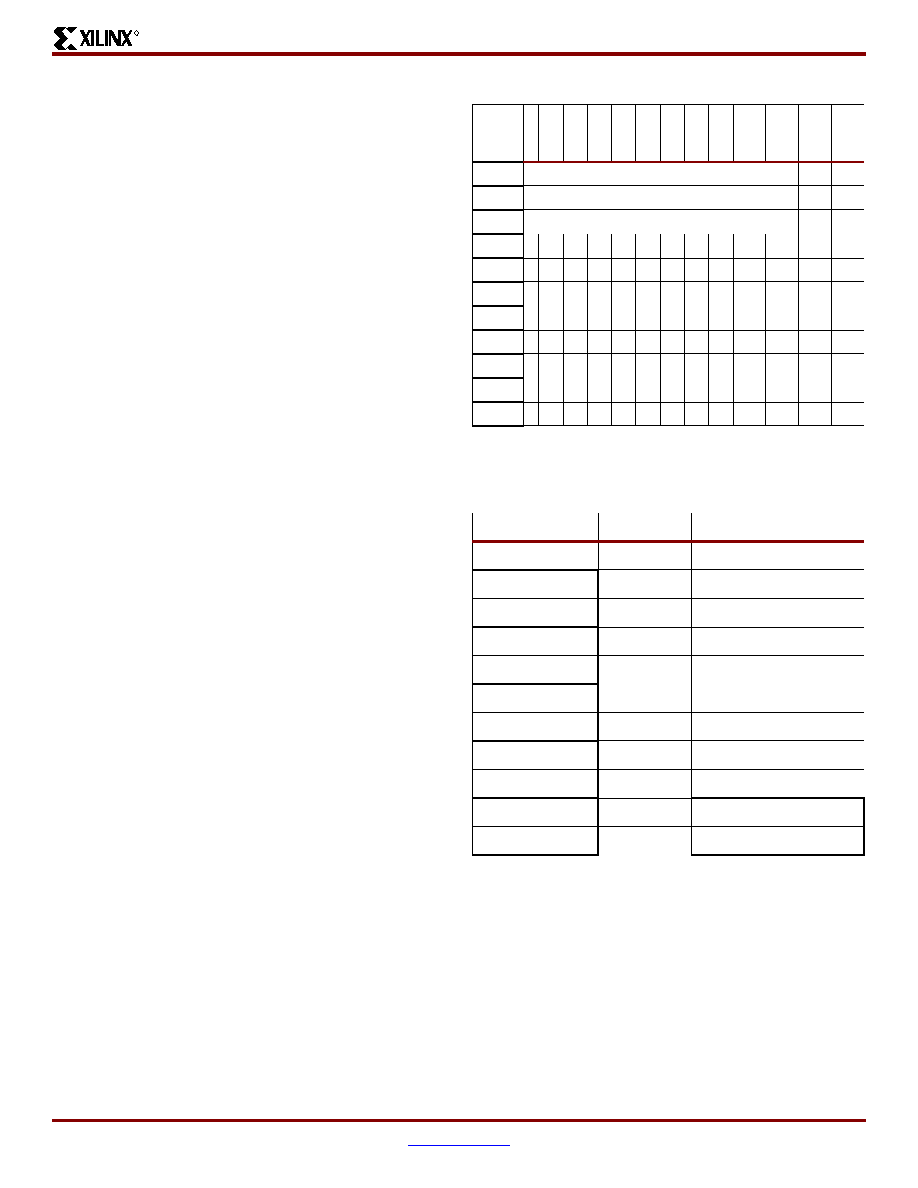- 您現(xiàn)在的位置:買(mǎi)賣(mài)IC網(wǎng) > PDF目錄4231 > XCV300E-7PQ240C (Xilinx Inc)IC FPGA 1.8V C-TEMP 240-PQFP PDF資料下載
參數(shù)資料
| 型號(hào): | XCV300E-7PQ240C |
| 廠商: | Xilinx Inc |
| 文件頁(yè)數(shù): | 13/233頁(yè) |
| 文件大小: | 0K |
| 描述: | IC FPGA 1.8V C-TEMP 240-PQFP |
| 產(chǎn)品變化通告: | FPGA Family Discontinuation 18/Apr/2011 |
| 標(biāo)準(zhǔn)包裝: | 24 |
| 系列: | Virtex®-E |
| LAB/CLB數(shù): | 1536 |
| 邏輯元件/單元數(shù): | 6912 |
| RAM 位總計(jì): | 131072 |
| 輸入/輸出數(shù): | 158 |
| 門(mén)數(shù): | 411955 |
| 電源電壓: | 1.71 V ~ 1.89 V |
| 安裝類(lèi)型: | 表面貼裝 |
| 工作溫度: | 0°C ~ 85°C |
| 封裝/外殼: | 240-BFQFP |
| 供應(yīng)商設(shè)備封裝: | 240-PQFP(32x32) |
第1頁(yè)第2頁(yè)第3頁(yè)第4頁(yè)第5頁(yè)第6頁(yè)第7頁(yè)第8頁(yè)第9頁(yè)第10頁(yè)第11頁(yè)第12頁(yè)當(dāng)前第13頁(yè)第14頁(yè)第15頁(yè)第16頁(yè)第17頁(yè)第18頁(yè)第19頁(yè)第20頁(yè)第21頁(yè)第22頁(yè)第23頁(yè)第24頁(yè)第25頁(yè)第26頁(yè)第27頁(yè)第28頁(yè)第29頁(yè)第30頁(yè)第31頁(yè)第32頁(yè)第33頁(yè)第34頁(yè)第35頁(yè)第36頁(yè)第37頁(yè)第38頁(yè)第39頁(yè)第40頁(yè)第41頁(yè)第42頁(yè)第43頁(yè)第44頁(yè)第45頁(yè)第46頁(yè)第47頁(yè)第48頁(yè)第49頁(yè)第50頁(yè)第51頁(yè)第52頁(yè)第53頁(yè)第54頁(yè)第55頁(yè)第56頁(yè)第57頁(yè)第58頁(yè)第59頁(yè)第60頁(yè)第61頁(yè)第62頁(yè)第63頁(yè)第64頁(yè)第65頁(yè)第66頁(yè)第67頁(yè)第68頁(yè)第69頁(yè)第70頁(yè)第71頁(yè)第72頁(yè)第73頁(yè)第74頁(yè)第75頁(yè)第76頁(yè)第77頁(yè)第78頁(yè)第79頁(yè)第80頁(yè)第81頁(yè)第82頁(yè)第83頁(yè)第84頁(yè)第85頁(yè)第86頁(yè)第87頁(yè)第88頁(yè)第89頁(yè)第90頁(yè)第91頁(yè)第92頁(yè)第93頁(yè)第94頁(yè)第95頁(yè)第96頁(yè)第97頁(yè)第98頁(yè)第99頁(yè)第100頁(yè)第101頁(yè)第102頁(yè)第103頁(yè)第104頁(yè)第105頁(yè)第106頁(yè)第107頁(yè)第108頁(yè)第109頁(yè)第110頁(yè)第111頁(yè)第112頁(yè)第113頁(yè)第114頁(yè)第115頁(yè)第116頁(yè)第117頁(yè)第118頁(yè)第119頁(yè)第120頁(yè)第121頁(yè)第122頁(yè)第123頁(yè)第124頁(yè)第125頁(yè)第126頁(yè)第127頁(yè)第128頁(yè)第129頁(yè)第130頁(yè)第131頁(yè)第132頁(yè)第133頁(yè)第134頁(yè)第135頁(yè)第136頁(yè)第137頁(yè)第138頁(yè)第139頁(yè)第140頁(yè)第141頁(yè)第142頁(yè)第143頁(yè)第144頁(yè)第145頁(yè)第146頁(yè)第147頁(yè)第148頁(yè)第149頁(yè)第150頁(yè)第151頁(yè)第152頁(yè)第153頁(yè)第154頁(yè)第155頁(yè)第156頁(yè)第157頁(yè)第158頁(yè)第159頁(yè)第160頁(yè)第161頁(yè)第162頁(yè)第163頁(yè)第164頁(yè)第165頁(yè)第166頁(yè)第167頁(yè)第168頁(yè)第169頁(yè)第170頁(yè)第171頁(yè)第172頁(yè)第173頁(yè)第174頁(yè)第175頁(yè)第176頁(yè)第177頁(yè)第178頁(yè)第179頁(yè)第180頁(yè)第181頁(yè)第182頁(yè)第183頁(yè)第184頁(yè)第185頁(yè)第186頁(yè)第187頁(yè)第188頁(yè)第189頁(yè)第190頁(yè)第191頁(yè)第192頁(yè)第193頁(yè)第194頁(yè)第195頁(yè)第196頁(yè)第197頁(yè)第198頁(yè)第199頁(yè)第200頁(yè)第201頁(yè)第202頁(yè)第203頁(yè)第204頁(yè)第205頁(yè)第206頁(yè)第207頁(yè)第208頁(yè)第209頁(yè)第210頁(yè)第211頁(yè)第212頁(yè)第213頁(yè)第214頁(yè)第215頁(yè)第216頁(yè)第217頁(yè)第218頁(yè)第219頁(yè)第220頁(yè)第221頁(yè)第222頁(yè)第223頁(yè)第224頁(yè)第225頁(yè)第226頁(yè)第227頁(yè)第228頁(yè)第229頁(yè)第230頁(yè)第231頁(yè)第232頁(yè)第233頁(yè)

Virtex-E 1.8 V Field Programmable Gate Arrays
R
DS022-2 (v3.0) March 21, 2014
Module 2 of 4
Production Product Specification
5
— OBSOLETE — OBSOLETE — OBSOLETE — OBSOLETE —
forces a storage element into the initialization state speci-
fied for it in the configuration. BY forces it into the opposite
state. Alternatively, these signals can be configured to oper-
ate asynchronously. All of the control signals are indepen-
dently invertible, and are shared by the two flip-flops within
the slice.
Additional Logic
The F5 multiplexer in each slice combines the function gen-
erator outputs. This combination provides either a function
generator that can implement any 5-input function, a 4:1
multiplexer, or selected functions of up to nine inputs.
Similarly, the F6 multiplexer combines the outputs of all four
function generators in the CLB by selecting one of the
F5-multiplexer outputs. This permits the implementation of
any 6-input function, an 8:1 multiplexer, or selected func-
tions of up to 19 inputs.
Each CLB has four direct feedthrough paths, two per slice.
These paths provide extra data input lines or additional local
routing that does not consume logic resources.
Arithmetic Logic
Dedicated carry logic provides fast arithmetic carry capabil-
ity for high-speed arithmetic functions. The Virtex-E CLB
supports two separate carry chains, one per Slice. The
height of the carry chains is two bits per CLB.
The arithmetic logic includes an XOR gate that allows a
2-bit full adder to be implemented within a slice. In addition,
a dedicated AND gate improves the efficiency of multiplier
implementation. The dedicated carry path can also be used
to cascade function generators for implementing wide logic
functions.
BUFTs
Each Virtex-E CLB contains two 3-state drivers (BUFTs)
that can drive on-chip buses. See Dedicated Routing.
Each Virtex-E BUFT has an independent 3-state control pin
and an independent input pin.
Block SelectRAM
Virtex-E FPGAs incorporate large block SelectRAM memo-
ries. These complement the Distributed SelectRAM memo-
ries that provide shallow RAM structures implemented in
CLBs.
Block SelectRAM memory blocks are organized in columns,
starting at the left (column 0) and right outside edges and
inserted every 12 CLB columns (see notes for smaller
devices). Each memory block is four CLBs high, and each
memory column extends the full height of the chip, immedi-
ately adjacent (to the right, except for column 0) of the CLB
column locations indicated in Table 3.
Table 4 shows the amount of block SelectRAM memory that
is available in each Virtex-E device.
As illustrated in Figure 6, each block SelectRAM cell is a
fully synchronous dual-ported (True Dual Port) 4096-bit
RAM with independent control signals for each port. The
data widths of the two ports can be configured indepen-
dently, providing built-in bus-width conversion.
Table 3: CLB/Block RAM Column Locations
XCV
Device
/Col.
0 12 24364860728496
108
120
138
156
50E
Columns 0, 6, 18, & 24
100E
Columns 0, 12, 18, & 30
200E
Columns 0, 12, 30, & 42
300E
√√
√
400E
√√
√
600E
√√
√
1000E
√ √
√
√√√
1600E
√ √√√
√√√
√
2000E
√ √√√
√√
√
2600E
√ √√√
√
3200E
√ √
√
√√√√
Table 4: Virtex-E Block SelectRAM Amounts
Virtex-E Device
# of Blocks
Block SelectRAM Bits
XCV50E
16
65,536
XCV100E
20
81,920
XCV200E
28
114,688
XCV300E
32
131,072
XCV400E
40
163,840
XCV600E
72
294,912
XCV1000E
96
393,216
XCV1600E
144
589,824
XCV2000E
160
655,360
XCV2600E
184
753,664
XCV3200E
208
851,968
相關(guān)PDF資料 |
PDF描述 |
|---|---|
| XCV300E-6PQ240I | IC FPGA 1.8V I-TEMP 240-PQFP |
| XCV300E-7FG256C | IC FPGA 1.8V C-TEMP 256-FBGA |
| SST39WF1602-70-4C-MAQE-T | IC MEM MPF 16MBIT FLASH 48WFBGA |
| SST39WF1602-70-4C-MAQE | IC FLASH MPF 16MBIT 70NS 48WFBGA |
| XC4VSX25-10FFG668I | IC FPGA VIRTEX-4 SX 25K 668FCBGA |
相關(guān)代理商/技術(shù)參數(shù) |
參數(shù)描述 |
|---|---|
| XCV300E-7PQ240C0773 | 制造商:Rochester Electronics LLC 功能描述: 制造商:Xilinx 功能描述: |
| XCV300E-7PQ240I | 功能描述:IC FPGA 1.8V I-TEMP 240-PQFP RoHS:否 類(lèi)別:集成電路 (IC) >> 嵌入式 - FPGA(現(xiàn)場(chǎng)可編程門(mén)陣列) 系列:Virtex®-E 產(chǎn)品變化通告:Step Intro and Pkg Change 11/March/2008 標(biāo)準(zhǔn)包裝:1 系列:Virtex®-5 SXT LAB/CLB數(shù):4080 邏輯元件/單元數(shù):52224 RAM 位總計(jì):4866048 輸入/輸出數(shù):480 門(mén)數(shù):- 電源電壓:0.95 V ~ 1.05 V 安裝類(lèi)型:表面貼裝 工作溫度:-40°C ~ 100°C 封裝/外殼:1136-BBGA,F(xiàn)CBGA 供應(yīng)商設(shè)備封裝:1136-FCBGA 配用:568-5088-ND - BOARD DEMO DAC1408D750122-1796-ND - EVALUATION PLATFORM VIRTEX-5 |
| XCV300E-7TQ144C | 制造商:XILINX 制造商全稱(chēng):XILINX 功能描述:Field Programmable Gate Arrays |
| XCV300E-7TQ144I | 制造商:XILINX 制造商全稱(chēng):XILINX 功能描述:Field Programmable Gate Arrays |
| XCV300E-8BG204C | 制造商:XILINX 制造商全稱(chēng):XILINX 功能描述:Virte -E 1.8 V Field Programmable Gate Arrays |
發(fā)布緊急采購(gòu),3分鐘左右您將得到回復(fù)。